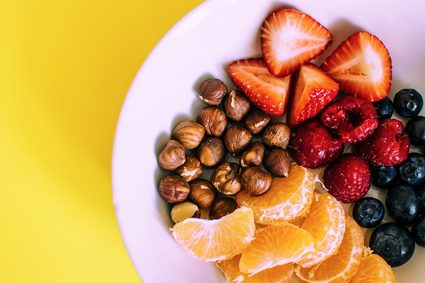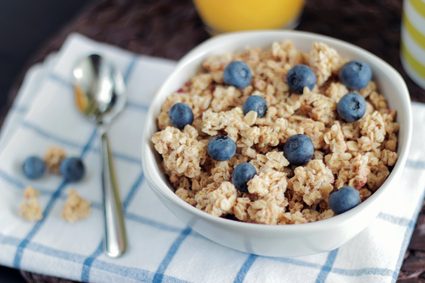Fiber Calculator
If you're interested in maintaining a healthy, balanced diet, this fiber calculator should grab your attention. After using it, you will no longer have to ask yourself, "How much fiber do I need?". Estimating your daily fiber intake helps you optimize your diet, which can make you healthier and happier. Read on to learn more about your recommended fiber intake, find out why fiber is important for your health, and get inspired to enrich your diet with our list of foods high in fiber.
And of course, remember that fiber is only one of the many nutrients important for your health - check out our macro calculator to learn more about your eating habits and what they mean for your body.
What is fiber, and why is it important?
Fiber is a dietary nutrient that comes from plants that mainly consists of carbohydrates. There's no need to worry about your blood sugar in this context, though; as opposed to other carbs, fiber cannot be broken down into digestible sugar molecules. Instead, it travels through your digestive system relatively untouched. It is important for reasons entirely different from most other nutrients.
Dietary fiber can be divided into two kinds, depending on how it acts in water: soluble and insoluble. The two types have different effects on your health but are equally important.
Let's go through some of the most important ways fiber can positively influence your health.
-
It's beneficial for your gut flora.
Gut flora are the microbes (mostly bacteria) that inhabit your gut. Experts estimate that these microbes can weigh as much as 2 kilograms - that's roughly the same as your brain! The thought of having more than a kilogram of bacteria in your body may sound alarming, but it's nothing to worry about - gut flora is crucial for your health. It helps you with many important processes, the earliest of which happens in infancy, where Bifidobacteria takes an active part in digesting the healthy sugars from breast milk. Some of the more notable gut flora functions include its participation in your immunity, and the surprising relations between the microbes and the central nervous system. indicate that deficits of certain gut bacteria may even be connected with depression.
So why is fiber important for your gut flora? It's simple - that's what the good bacteria "eat"! When they metabolize fibers, they break them down into , killing two birds with one stone - keeping both themselves and you in peak condition. Isn't symbiosis beautiful?
-
It can reduce bad cholesterol.
Studies show that a diet rich in soluble fibers can lead to reduced levels of low-density lipoprotein, more commonly known as LDL, or bad cholesterol.
Please note that if you have a problem keeping your cholesterol at healthy levels, increasing your fiber intake will most likely not be a cure-all, and it's vital that you remain in touch with your doctor. However, it's generally agreed upon (and confirmed by a vast number of observational studies) that sticking to the recommended daily fiber intake correlates with a lower risk of heart disease.
-
It normalizes bowel movements and helps maintain bowel health.
Fiber helps avoid constipation by increasing the bulk of stool, softening it, and speeding up its journey through your intestines. On the other hand, its water-absorbing qualities can help solidify loose stool. What's more, people who meet their recommended fiber intake are at lower risk of developing hemorrhoids and diverticular disease.
-
It likely reduces colorectal cancer risk.
Although the direct link is not yet known for sure, . Some scientists search for the cause of this effect within fiber's ability to limit the contact carcinogens from food have with the human intestine, while others see it as activity of the gut bacteria mentioned above. While it's still unclear how it works exactly, the correlation between healthy fiber intake and the reduced risk of colorectal cancer has been found in various studies and is therefore hard to ignore.
Keep in mind that the key to gut health is moderation. Too much fiber in your diet may lead to unpleasant effects, such as gas, bloating, or even constipation!
How to use the fiber calculator?
To calculate your recommended fiber intake, follow these instructions:
- Start by selecting your biological sex;
- Input your height;
- Input your current weight;
- Put in your age;
- Decide what your activity level is for a typical week;
- Let the fiber calculator use the information you provided to calculate your recommended daily calorie intake; and
- Finally, it will use the calories you need to determine what your daily fiber intake should be.
How to calculate my recommended fiber intake?
Calculating your own fiber intake is pretty simple. Experts recommend consuming 14 grams of fiber for every 1,000 calories you consume per day. The equation is as follows:
daily fiber intake = daily calories / 1,000kcal * 14g
So, if you typically eat 2,500 calories every day, you should make sure that your meals contain at least 35 grams of fiber, as you can see in the following calculation: 2,500kcal / 1,000kcal * 14g = 2.5 * 14g = 35g
Foods high in fiber
Now that the questions of "How much fiber do I need?" and "Why does it matter?" have been answered, it's time to put that knowledge to use. The next step is to enrich your diet with foods high in fiber. But what are they, and how to turn them into exciting and attractive dishes?
Alongside the fiber calculator, we've prepared a list of some of the more popular foods high in fiber, as well as several ideas for easy, delicious, and fiber-rich meals.
FIBER RICH FOODS INCLUDE:
-
Fruits: bananas, apples, mangoes, strawberries, raspberries, blueberries, persimmons, kiwis, pears, oranges, tangerines, apricots, peaches, and grapes.
-
Veggies: spinach, carrots, beets, broccoli, sweet potatoes, collard greens, squash, Brussels sprouts, asparagus, kale, eggplant, and tomatoes.
When it comes to veggies and fiber, a good rule of thumb is: the darker, the better.
-
Legumes: chickpeas, lentils, green peas, kidney beans, soybeans.
Legumes are also a great source of protein, which is especially important if you are a vegetarian or vegan.
-
Nuts and seeds: chia seeds, flax seeds, pumpkin seeds, sunflower seeds, dried coconut, almonds, pistachios, chestnuts, hazelnuts, and pecans.
-
Whole grains: bulgur, pearl barley, quinoa, whole wheat, oatmeal, brown rice, millet, couscous, bran, corn.

Increase your daily fiber intake by enriching your breakfast
Do you typically start your day with eggs and sausages? Or do you skip breakfast altogether, opting instead for a cup of coffee? We propose that you challenge these habits and try out this fiber-rich breakfast.

BLUEBERRY OATMEAL RECIPE
What you need:
- 2 cups of rolled oats or oatmeal;
- 2 cups of water or milk;
- 1 cup of fresh blueberries;
- 1/2 cup of ground flaxseed; and
- 2 tsp of cinnamon.
Preparation: Boil water/milk, add oats, and turn the heat down to low. Mix often to keep the oats from sticking to the bottom of the pot. While boiling, add cinnamon. When the oats become soft, turn off the heat, mix in flaxseed, pour your oatmeal into bowls, and top the dish with blueberries.
OTHER FIBER-RICH BREAKFAST IDEAS
Oatmeal is arguably the best way to go when it comes to breakfast foods high in fiber - it's fast, easy, and can be prepared with so many different toppings that you could probably eat it every day for a month and not get bored. However, it's not the only option. Here are some other ideas you can try out:
- Whole wheat pancakes - simply exchange regular flour with whole wheat while making pancakes. Add some delicious fiber-rich fruit or nuts as a topping for the best effect!
- Peanut butter toast with a twist - use whole wheat bread and sprinkle your good ol' PB&J with some chia or flax, and enjoy a whole new version of the classic sandwich.
- Sweet potato breakfast hash browns - sweet potatoes are richer in fiber than their regular counterparts. Try to use them next time you're preparing hash browns!
- Blueberry and chia smoothie - throw a bunch of blueberries, a banana, and yogurt in your blender, add chia seeds, and voila! Enjoy a quick, effortless, and fiber-rich breakfast.
How else can you improve your diet and general well-being?
If you're interested in other ways to keep healthy and improve your diet, we're glad to help! The first step to becoming a healthier person is knowing your body - you can start by calculating your BMI as well as using the ideal weight calculator.*
Once you know where you stand, consider using the following healthy lifestyle tips:
- Make sure that you don't exceed your optimal fat intake - you can find it with the help of the fat intake calculator.
- Cut down on extra carbs by swapping regular sweets for their healthier counterparts. For example, consider eating dark chocolate instead of milk or white. Dark chocolate is rich in iron, magnesium and other valuable elements important for your health.
- Get moving! If you're not very active, you can start by taking walks regularly. If you have a dog, you can try some new activities such as agility, which will also benefit your pet. You can also kill two birds with one stone and do some simple housework, which saves money on professional services and burns calories at the same time. For example, did you know that mowing grass burns about 250-350 calories per hour?
*Please keep in mind that in some cases, the standard ways of calculating healthy weight don't apply, especially when planning a new diet. If you're with a child, please use our pregnancy weight gain calculator instead. If your body-mass index is high, consider using the adjusted body weight calculator for accurate results.
We try our best to make our Omni Calculators as precise and reliable as possible. However, this tool can never replace professional medical advice.